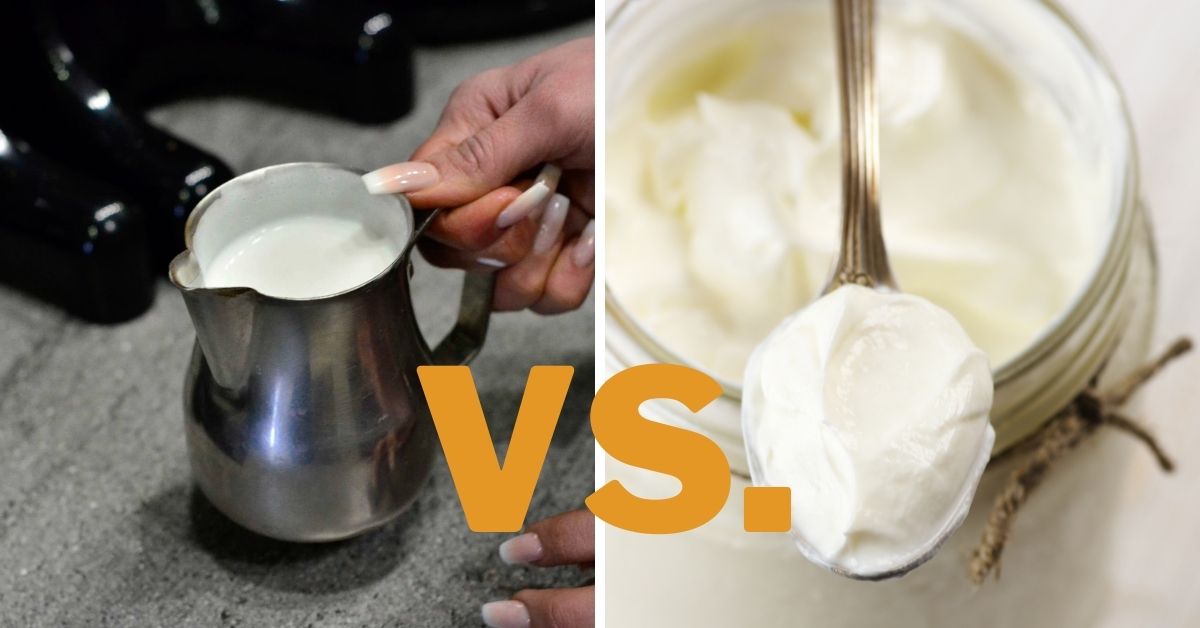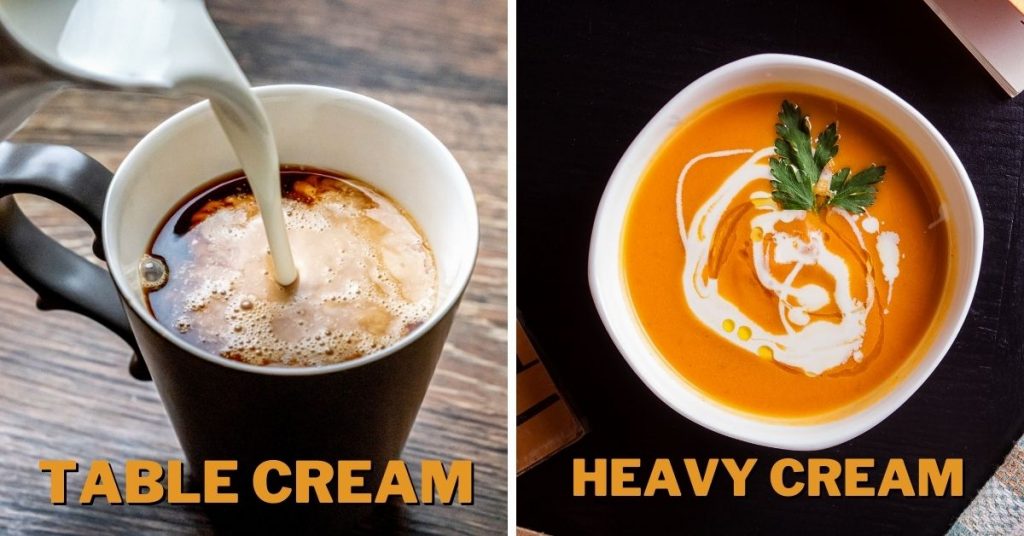Table Cream vs. Heavy Cream: Differences & Uses

When you go to buy cream, you will notice many names for it – light cream, heavy cream, whipping cream, sour cream, double cream, etc. Among these variations, we are going to focus today on table cream and heavy cream. How are these two types of cream different? And how do you use table cream and heavy cream?
Table cream is cream that contains 18-30% milk fat whereas heavy cream contains at least 36%. So, heavy cream is richer and more stable when you turn it into whipped cream. Typically, light cream is used in coffee or drizzled over cakes. Heavy cream is used to make more decadent desserts.
Due to their varying degrees of fat content, different types of cream function differently in cooking or baking. And it is important to know these differences to get the most out of cream. so, in this article, we are going to highlight how heavy cream and table cream differ from each other in terms of taste, appearance, texture, nutrition, etc.
Table Cream vs. Heavy Cream: Differences
Let’s start with the composition of these two types of cream.
Composition
Not all creams are created equally. The biggest point of distinction among the types is usually the amount of fat present in them. Most traditional creams are made from milk, especially cow’s milk. And depending on how much of the milk fat persists by the end of production, you get different milk.
So, table cream is cream that has anywhere between 16 to 20% of milk fat. The exact amount will vary depending on the brand and the region where you buy it from.
In contrast, heavy cream has to contain at least 36% milkfat or else the manufacturer cannot label it as “heavy cream”. If the fat content is lower, then it falls in the domain of “light whipping cream”. The maximum level of fat is unspecified. But usually, it is between 38 to 50 grams. In the UK, you can consider clotted cream, which has 55% fat, as technically heavy cream.
Taste and Texture
The difference in fat level also affects the overall taste of the products. Heavy cream has a richer taste and a thicker consistency. Table cream is much smoother and lighter. This is why people prefer to use table cream in their coffee, as the lighter consistency means it will mix better with the brew.
Appearance
Usually, table cream is in the form of a thick, creamy liquid. From a distance, it looks indistinguishable from regular milk. In comparison, you will find heavy cream as either a thick liquid or actual cream. Since it has a higher fat content, heavy cream is more stable. Thus, it can hold a more solid shape compared to light cream.
Uses
Typically, table cream is used in coffee or other drinks to make them richer and creamier. Additionally, you can drizzle this cream over cakes and fresh fruit in the summertime. Since it has a relatively low-fat content, it is not ideal to heat this cream or whip it. Because doing so may end curdling the cream easily.
Heavy cream, on the other hand, has a much higher amount of fat. As such, you can easily turn this into whipping cream. This is the reason why this cream is also referred to as “heavy whipping cream”.
In fact, heavy cream is more suitable for whipping compared to actual “whipping cream.” Because the more fat is present in the cream, the more stable it is when you whip it. So, while you can certainly whip “whipping cream”, you will get a better result with heavy cream. Heavy cream will produce much stiffer and shinier peaks.
Moreover, people use heavy cream in different desserts such as cake, cheesecake, pudding, tiramisu, etc. This cream is less susceptible to heat when exposed to high heat thanks to its high-fat level. So, you can add this cream to things such as soups and sauces without worrying about curdling.

Nutrition
Depending on which brand’s product you are buying, the exact nutritional value is going to vary. But for heavy cream, you need at least 36% fat. In contrast, light cream can have anywhere between 16 to 20% of fat. Meaning, that heavy cream has almost twice the amount of fat compared to table cream. [1] [2]
This also means that heavy cream generates much more calories compared to table cream. This is a very important aspect to consider for people on a restrictive diet.
Let’s sum up the differences between table cream and heavy cream in the table.
| Features | Table Cream | Heavy Cream |
|---|---|---|
| Appearance | Almost always liquid | Can be liquid or whipped into a solid. |
| Composition | 16-30% milk fat | At least 36% milk fat |
| Taste | Lighter and smoother | Thicker and creamier |
| Use | Coffee creamer | Whipped cream, decadent desserts |
| Nutrition | Fewer calories | More calories |
Table Cream vs. Heavy Cream: Which Is Better?
As you have probably surmised by now, heavy cream and table cream have different properties which makes them useful in different scenarios.
If you are looking for a way to make your sauces and desserts creamier, then heavy cream is the better choice. It will not curdle too easily when you cook it at a high temperature. Similarly, if you want to make whipped cream or the baking process involves whipping cream with other ingredients, heavy cream is a much more stable option to choose.
On the flip side, if you are looking for a nice addition to your morning cup of coffee, then a serving of table cream is the way to go. Also, table cream produces much fewer calories. So, for people looking for a low-calorie option, table cream is the better choice. Light cream is great in that it will give you that rich taste without overloading on either fat or calories.
Can You Use Table Cream Instead of Heavy Cream?
Since the level of fat is so different between the two options, using table cream instead of heavy cream will most likely not produce the same results. But, in some cases, you can use table cream as a substitute if you happen to run out of its heavier counterpart.
If your recipe calls for liquid heavy cream, then you can table cream after you reduce it on a stove. This is the same process for making evaporated milk, which is where you remove much of the water. This will help create a thicker and richer tasting cream, although the result will not be identical.
Similarly, you can mix light or table cream with butter to increase its fat content. Since butter is almost entirely milkfat (80% minimum), this process will make table cream thicker and creamier. As a guideline, you can substitute one cup of heavy cream with a mixture of ¾ cup of table cream and ¼ cup of melted butter.
In cases where you need to whip the cream or cook it at high temperatures, you really cannot table cream as a substitute. Because this cream is not stable enough and will end up curdling long before you reach your goal.
Can You Use Heavy Cream Instead of Table Cream?
Likewise, heavy cream is not an ideal substitute for table cream. You are going to get a thicker and creamier result if you do so, which is not always desirable. However, if you do not mind the increased number of calories or richness, then you can substitute table cream with liquid heavy cream.
To conclude, adding cream to anything, be it coffee, a dessert, or even a savory dish, just makes life that much richer and, of course, creamier. And with different types of cream, you have plenty of options to choose from.
